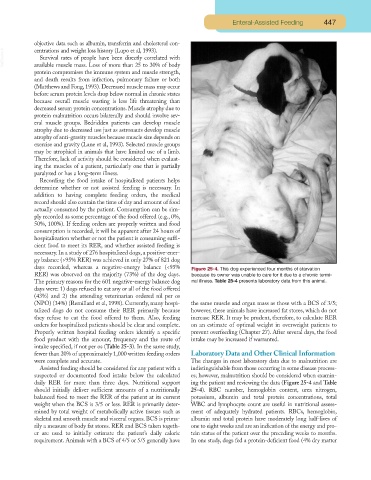Page 433 - Small Animal Clinical Nutrition 5th Edition
P. 433
Enteral-Assisted Feeding 447
objective data such as albumin, transferrin and cholesterol con-
VetBooks.ir centrations and weight loss history (Lupo et al, 1993).
Survival rates of people have been directly correlated with
available muscle mass. Loss of more than 25 to 30% of body
protein compromises the immune system and muscle strength,
and death results from infection, pulmonary failure or both
(Matthews and Fong, 1993). Decreased muscle mass may occur
before serum protein levels drop below normal in chronic states
because overall muscle wasting is less life threatening than
decreased serum protein concentrations. Muscle atrophy due to
protein malnutrition occurs bilaterally and should involve sev-
eral muscle groups. Bedridden patients can develop muscle
atrophy due to decreased use just as astronauts develop muscle
atrophy of anti-gravity muscles because muscle size depends on
exercise and gravity (Lane et al, 1993). Selected muscle groups
may be atrophied in animals that have limited use of a limb.
Therefore, lack of activity should be considered when evaluat-
ing the muscles of a patient, particularly one that is partially
paralyzed or has a long-term illness.
Recording the food intake of hospitalized patients helps
determine whether or not assisted feeding is necessary. In
addition to having complete feeding orders, the medical
record should also contain the time of day and amount of food
actually consumed by the patient. Consumption can be sim-
ply recorded as some percentage of the food offered (e.g., 0%,
50%, 100%). If feeding orders are properly written and food
consumption is recorded, it will be apparent after 24 hours of
hospitalization whether or not the patient is consuming suffi-
cient food to meet its RER, and whether assisted feeding is
necessary. In a study of 276 hospitalized dogs, a positive-ener-
gy balance (>95% RER) was achieved in only 27% of 821 dog
days recorded, whereas a negative-energy balance (<95% Figure 25-4. This dog experienced four months of starvation
RER) was observed on the majority (73%) of the dog days. because its owner was unable to care for it due to a chronic termi-
The primary reasons for the 601 negative-energy balance dog nal illness. Table 25-4 presents laboratory data from this animal.
days were: 1) dogs refused to eat any or all of the food offered
(43%) and 2) the attending veterinarian ordered nil per os
(NPO) (34%) (Remillard et al, 1998). Currently, many hospi- the same muscle and organ mass as those with a BCS of 3/5;
talized dogs do not consume their RER primarily because however, these animals have increased fat stores, which do not
they refuse to eat the food offered to them. Also, feeding increase RER. It may be prudent, therefore, to calculate RER
orders for hospitalized patients should be clear and complete. on an estimate of optimal weight in overweight patients to
Properly written hospital feeding orders identify a specific prevent overfeeding (Chapter 27). After several days, the food
food product with the amount, frequency and the route of intake may be increased if warranted.
intake specified, if not per os (Table 25-3). In the same study,
fewer than 20% of approximately 1,000 written feeding orders Laboratory Data and Other Clinical Information
were complete and accurate. The changes in most laboratory data due to malnutrition are
Assisted feeding should be considered for any patient with a indistinguishable from those occurring in some disease process-
suspected or documented food intake below the calculated es; however, malnutrition should be considered when examin-
daily RER for more than three days. Nutritional support ing the patient and reviewing the data (Figure 25-4 and Table
should initially deliver sufficient amounts of a nutritionally 25-4). RBC number, hemoglobin content, urea nitrogen,
balanced food to meet the RER of the patient at its current potassium, albumin and total protein concentrations, total
weight when the BCS is 3/5 or less. RER is primarily deter- WBC and lymphocyte count are useful in nutritional assess-
mined by total weight of metabolically active tissues such as ment of adequately hydrated patients. RBCs, hemoglobin,
skeletal and smooth muscle and visceral organs. BCS is prima- albumin and total protein have moderately long half-lives of
rily a measure of body fat stores. RER and BCS taken togeth- one to eight weeks and are an indication of the energy and pro-
er are used to initially estimate the patient’s daily caloric tein status of the patient over the preceding weeks to months.
requirement. Animals with a BCS of 4/5 or 5/5 generally have In one study, dogs fed a protein-deficient food (4% dry matter

